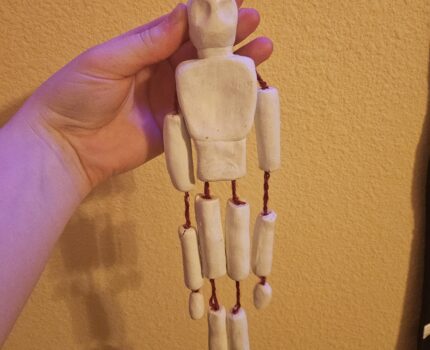
For my STEAM Project I chose to research and represent Ehler-Danlos Syndrome, or EDS, and specifically how it affects joints and joint movement. I represented this by creating a clay doll, and connecting most of the joints by red string to emphasize the “loose” feeling of joints in people with hypermobile EDS. My original idea for this project was to do something with string or yarn, by possibly crocheting to display the less stable connective tissue. However, I spoke to a friend who has EDS, and after hearing her experience with joint problems I decided to focus on that. I also chose red string specifically to connect the joints because there can be a lot of pain in joints for people with EDS, and I wanted to express the idea of inflammation.
Ehlers-Danlos Syndrome is a connective tissue condition that can cause symptoms of joint instability, easy bruising and or wounding of the skin, and fragile veins and arteries (Shirley et al., 2012). EDS can affect one or more areas of the body, causing one or more of the symptoms (Mayo Clinic, 2022). For example, EDS is some people only affects their joints and causes hypermobility, while some forms of EDS can affect arteries and veins which causes a much higher risk of ruptures (Mayo Clinic, 2022).
One of the main causes of the weakening of connective tissue from EDS is rooted in genetic mutations that affect the amount of collagen within the tissue (Shirley et al., 2012). Since my project is focused on the hypermobility within joints, I am going to give more background on that. Hypermobility can be caused by other joint issues, but is a common symptom of EDS (Shirley et al., 2012). A person with hypermobility may be able to bend their joints abnormally past their usual stopping points; bending the knees and elbows backwards, more backwards movement within the finger joints, abnormally large range of motion within the shoulders (Shirley et al., 2012). Hypermobility within the joints can increase the risk of dislocation and tendon rupturing , as well as cause pain and inflammation from the lack of stability and cushioning within the joints (Shirley et al., 2012). While dislocation and rupturing can be caused by trauma to the joint, in people with EDS having many repeated occurrences of dislocation and rupturing is common (Shirley et al., 2012).
EDS can heavily affect quality of life, as hypermobility can cause bigger problems over time (Scheper et al., 2017). In this study published by Oxford University, 101 children with EDS, and or other hypermobility issues, were assessed over a period of 3 years to track quality of life and the level of disability the hypermobility caused (Scheper et al., 2017). The results showed that there was a reduced ability to walk far distances, lower quality of life, fatigue, and problems controlling posture (Scheper et al., 2017). Based on the assessments of 3 years, the children were likely to experience worsening effects as they age due to their hypermobility (Scheper et al., 2017).
Hypermobility from EDS can be very hard to live with, and I tried to express the uncomfortable effects of the condition through my project. EDS can be treated through physical therapy, as well as braces around joints to supply stability (Shirley et al., 2012). But, even with these supplements the condition can still heavily affect daily life, and my project aims to emphasize that.
References
Mayo Clinic. (2022, August 25). Ehlers-Danlos syndrome – Symptoms and causes. Mayo Clinic. Retrieved November 21, 2024, from https://www.mayoclinic.org/diseases-conditions/ehlers-danlos-syndrome/symptoms-causes/syc-20362125
Scheper, M. C., Nicholson, L. L., Adams, R. D., Tofts, L., & Pace, V. (2017, December 1). The natural history of children with joint hypermobility syndrome and Ehlers-Danlos hypermobility type: a longitudinal cohort study. PubMed. Retrieved November 5, 2024, from https://pubmed.ncbi.nlm.nih.gov/28431150/Shirley, E. D., DeMaio, M., & Bodurtha, J. (2012). Ehlers-Danlos Syndrome in Orthopaedics: Etiology, Diagnosis, and Treatment Implications. PubMed Central. Retrieved November 5, 2024, from https://pmc.ncbi.nlm.nih.gov/articles/PMC3435946/

